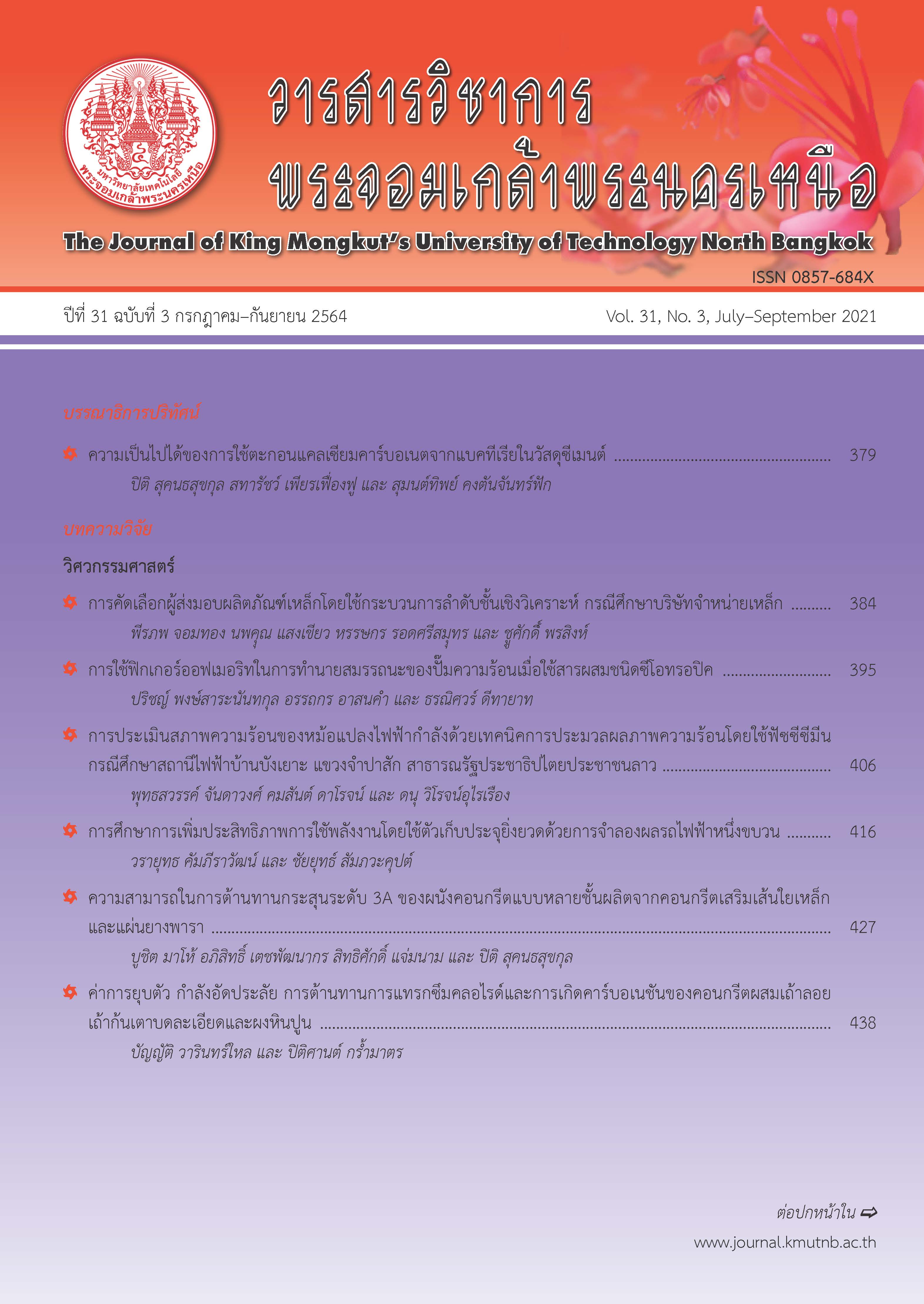พฤติกรรมการระเบิดในท่อเหล็กและแนวทางการประเมินอันตราย
Main Article Content
บทคัดย่อ
งานวิจัยนี้ได้ศึกษาพฤติกรรมการระเบิดในท่อเหล็ก (Pipe Bomb) โดยวัดค่าและเปรียบเทียบระดับความเสียหายจากการระเบิดที่เกิดขึ้นกับแผ่นพื้นคอนกรีตและฉากรับสะเก็ดระเบิด ตัวแปรที่ส่งผลต่อระดับความเสียหายถูกกำหนดไว้สองส่วนคือ ปริมาณวัตถุระเบิดและปริมาตรของภาชนะท่อเหล็ก กำหนดการทดสอบเป็น 6 แบบเพื่อพิจารณาผลจากตัวแปรดังกล่าวได้แก่ ระเบิดทีเอ็นที 1/4 ปอนด์ไม่บรรจุท่อเหล็ก ระเบิดทีเอ็นที 1/4 ปอนด์ในท่อเหล็กขนาดเล็ก ระเบิดทีเอ็นที 1/2 ปอนด์ในท่อเหล็กขนาดเล็ก ระเบิดทีเอ็นที 1 ปอนด์ในท่อเหล็กขนาดกลาง ระเบิดทีเอ็นที 1/4 ปอนด์ในท่อเหล็กขนาดกลาง และระเบิดทีเอ็นที 1/4 ปอนด์ในท่อเหล็กขนาดใหญ่ ผลการทดสอบพบว่า แรงดันจากการระเบิดทีเอ็นที 1/4 ปอนด์ในท่อเหล็กขนาดเล็กมีค่าประมาณ 40 เปอร์เซ็นต์เมื่อเทียบกับแรงดันจากการระเบิดทีเอ็นที 1/4 ปอนด์ไม่บรรจุท่อเหล็ก (Bare Charge) แต่ความเสียหายที่เกิดขึ้นกับแผ่นพื้นคอนกรีตมีความรุนแรงมากกว่า และเมื่อเพิ่มปริมาณระเบิด Pipe Bomb ความเสียหายของแผ่นพื้นคอนกรีตจะเพิ่มมากขึ้น ส่วนการเพิ่มปริมาตรท่อเหล็กไม่พบว่ามีความเสียหายแตกต่างกันอย่างชัดเจน เมื่อพิจารณาลักษณะสะเก็ดระเบิดที่เกิดขึ้นพบว่า ปริมาณระเบิด Pipe Bomb ที่เพิ่มขึ้นส่งผลให้สะเก็ดระเบิดมีขนาดเล็กลงและมีจำนวนมากขึ้น ส่วนการเพิ่มปริมาตรท่อเหล็กไม่พบว่าขนาดและจำนวนสะเก็ดแตกต่างกันอย่างชัดเจน งานวิจัยนี้ยังได้เสนอแนวทางประเมินอันตรายจากการระเบิดอย่างง่ายซึ่งพบว่า อันตรายจากสะเก็ดระเบิดมีขอบเขตที่กว้างกว่าอันตรายจากแรงระเบิด
Article Details
บทความที่ลงตีพิมพ์เป็นข้อคิดเห็นของผู้เขียนเท่านั้น
ผู้เขียนจะต้องเป็นผู้รับผิดชอบต่อผลทางกฎหมายใดๆ ที่อาจเกิดขึ้นจากบทความนั้น
เอกสารอ้างอิง
[2] Prince of Songkla University (2020, March). Deep South Watch. [Online]. Available: https://deepsouthwatch.org/th/dsid (in Thai)
[3] Royal Thai Police Bomb Data Center (2015, August). Activities of Office of Forensic Science. [Online]. Available: http://thaibdc.forensic.police.go.th/?p=523 (in Thai)
[4] G. Tanapornraweekit and S. Tangtermsirikul, “Lethal area from blast and fragment of pipe bomb,” Thai Journal of Science and Technology, vol. 24, no. 3, pp. 514–524, 2016 (in Thai).
[5] Handbook for Blasting Calculation and Blast Effect on Building Structure, Department of Public Works and Town & Country Planning, Bangkok, Thailand, 2016, pp. 3–8, a–4 (in Thai).
[6] A manual for the prediction of blast and fragment loadings on structures, U.S. Department of Energy, 1981, pp. 6–1.
[7] A. Malhotra, D. Carson, and S. M. Fadden, “Blast pressure leakage into building and effect on humans,” Procedia Engineering, vol. 210, pp. 386–392, 2017.
[8] Federation of American Scientists, Military Analysis Network (1998, January). Damage Criterial. [Online] Available: https://fas.org/man/dod-101/navy/docs/es310/dam_crit/dam_crit.html
[9] J.C. Oxley, J.L. Smith, E.T. Bernier , F. Sandstrom, G.G. Weiss, G.W. Recht, and D. Schatzer, “Characterizing the performance of pipe bombs,” Journal of Forensic Sciences, vol. 63, no. 1, pp. 86–101, 2018.
[10] M. D. Hutchinson, “With-fracture gurney model to estimate both fragment and blast impulses,” Central European Journal of Energetic Materials, vol. 7 no. 2, pp. 175–186, 2010.
[11] E. M. Fisher, The Effect of the Steel Case on the Air Blast from High Explosive. Defense Technical Information Center., 1953.
[12] V. Karlos and G. Solomos, Calculation of Blast Loads for Application to Structural Components. Italy: Publications Office of the European Union, 2013, pp. 22.
[13] R. W. Gurney, The initial velocities of fragments from bombs, shell and grenades, Ballistic Research Laboratories (BRL), 1943.
[14] International Ammunition Technical Guideline (IATG), United Nations Office for Disarmament Affairs (UNODA). New York, USA, 2015, pp. 10.
[15] Structure to Resist the Effects of Accidental Explosions (UFC 3-340-02). U.S. Department of Defense, 2008, pp. 2–294.

